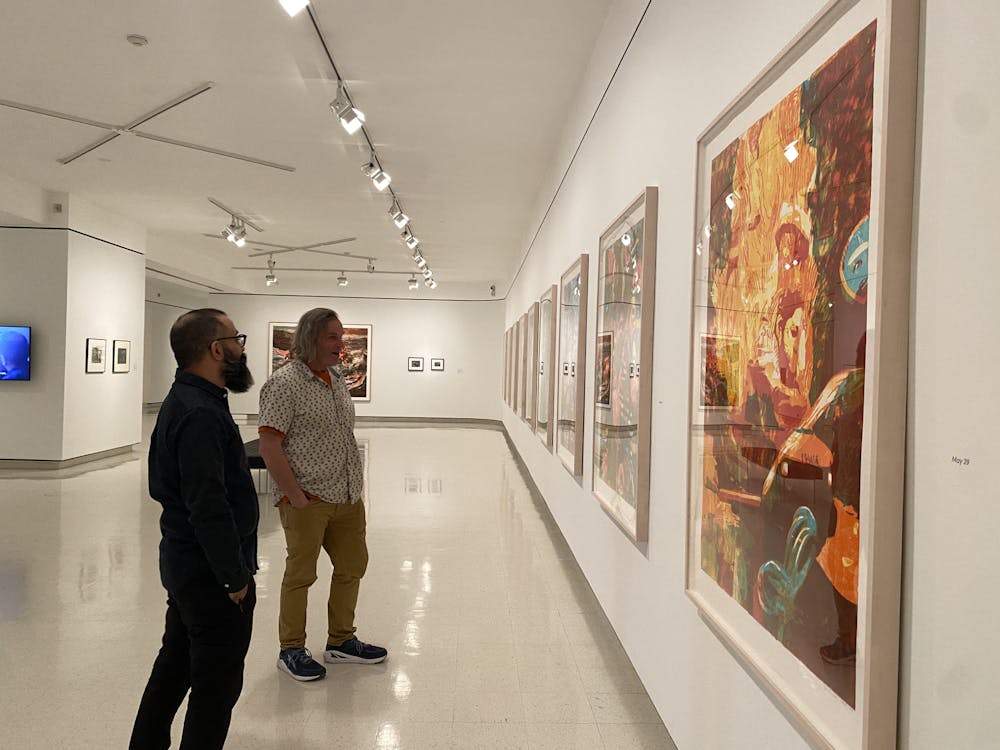When artist and SUNY Purchase professor Rob Swainston rode his bicycle down the streets of New York City during the first COVID-19 lockdown, he photographed the plywood-covered storefronts, meant to deter protestors.
Before the plywood could be thrown out, artists Zorawar Sidhu and Swainston decided to turn it into art. They reused the plywood that boarded up the Whitney Museum and the Museum of Modern Art, printing images of what happened in 2020 and 2021.
Before COVID-19 ravaged the U.S., Sidhu and Swainston had already been following the news of protests in Hong Kong where images of the tear gas, masks and police struck them.
Once lockdown was in full effect, Sidhu and Swainston found themselves caught in a repetitive news cycle filled with the urgency of the coronavirus, the murder of George Floyd and the imminent presidential election.
They found refuge in Zoom meetings together. The pair collected images of what was in the news and discussed how to translate those images into different layers on woodcut prints.
In “History is Present,” Swainston and Sidhu decelerate the diminishing of these images and lend a slowness to the urgency of our present by reflecting on the past. The series, “Doomscrolling,” features 18 images from between May 24, 2020 and Jan. 6, 2021. It’s meant to prompt a vivid recollection that verbal cues could not: the fabled fly that landed on Mike Pence’s head during the vice presidential debate in 2020, the NYPD vehicle set on fire by protestors, Trump holding the Bible upside down, the protestors swarming the Capitol on Jan. 6.
Swainston and Sidhu, who have been collaborators for four years, spent between “a couple of weeks to six months” on each print, with some of them having been developed in real time. Their “August 25” piece of Kyle Rittenhouse hovering over a victim with his gun was a piece that they started promptly after Rittenhouse shot three people in Kenosha, Wisconsin, and finished during Rittenhouse’s trial.
“Now we have it on the wall, and Kyle Rittenhouse has just come out with a book. Everyone’s relationship with this particular event is still unresolved,” Sidhu said in an interview with The Spectrum.
In “May 24,” a woman scrolls on her phone at night in bed, the screen illuminating her eyes. The total blueness surrounding her strikes a resemblance to the blue light that keeps us up at night — even if we put our phone down, could we fall asleep?
Another layer reveals the woman’s screen — a front page of The New York Times with the headline “U.S DEATH TOLLS REACH 100,000, AN INCALCULABLE LOSS.” Another layer of red, rounded lines form fingerprints on the image, the manifestation of scrolling.
“The theory is that if you can slow down and have someone look at something again and again and again at the same thing, then it’s no longer just the fact that they can be indignant about and they’re no longer passive about,” Swainston said. “They are actually participating in the meaning of it.”
Throughout the gallery, historical references from artists like Käthe Kollwitz, a German printmaker from the late 1800s, contextualize Sidhu and Swainston’s practice. Hands from Kollwitz’s “Kindersterben” from 1925 are restored to the raised arms of a protestor in “May 26,” shadows from Edvard Munch’s “Vampyr II” shape Anthony Huber, a skateboarder shot by Kyle Rittenhouse, who lies wounded on the ground; rays of light from Albrecht Dürer’s “The Opening of the Fifth and Sixth Seals” stream from the headlights of a police car in “August 25.”
“The way we talk about present events is complicated because everyone wants to take sides in the current room. The way to do it is to talk about the older events and so by referencing [Theodore] Gericault’s Raft of the Medusa, we can talk about a refugee crisis today that’s going to happen again in the Middle East without directly talking about that event because it’s so polarizing,” said Swainston.
While these images may remind us of how polarized our nation has become, the reds and blues are divorced from suggesting any support to partisan associations. The bright collection of oranges, purples, pinks and a spectrum of other colors forge an equally bright outlook towards changing our country’s conditions together.
The “History is Present” exhibition is on view at UB’s Anderson Gallery until July 26.
Tenzin Wodhean is an arts editor and can be reached at tenzin.wodhean@ubspectrum.com





